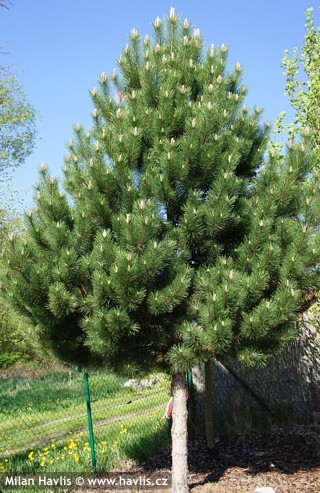Pinus nigra ssp. nigra (austriaca)

Pinus nigra ssp. nigra (austriaca)
Austrian pine
Austrian pine
| SIZE/TYPE | tall tree |
|---|---|
| USUAL HEIGHT | 10-30m |
| USUAL WIDTH | 6-8m |
| LEAVES | evergreen conifer |
| COLOUR OF LEAVES |
 green green |
| FLOWERS | insignificant or non-blooming |
| LOCATION | full to partial sun |
| USDA zone (lowest) | 3 (down to -40°C) |
| WINTER PROTECTION | |
| FOR ZONE 5+6 |

|
| FOR ZONE 7 |

|
| BELONGS TO CATEGORIES | Conifers |
Austrian (black) pine was first classified by Austrian botanist Johann Arnold in 1785. It is a hardy tree which escaped Austria in early 20th century, and can now be found all around Europe, down to Turkey, and in North Africa. Hard to say if Mother Nature needed a stronger substitute for more tender species in the ever-changing climate, or whether this one is simply invasive. In any case its more than a century old journey has proved its toughness and durability.
Austrian pine is a variable species and is therefore divided into subspecies where each one reflects its location and appearance. Pinus nigra ssp. nigra (or ssp. austriaca) is the one found all around Europe except the south (ssp. salzmannii is at home there). It produces 10-15 cm long, dark green, slightly glossy, erect, stiff needles in bundles of two. It grows medium fast to fast with 20-40 cm per year, forming a symmetrical, well-branched tree. It keeps its lower branches and grows slower if fully insolated top to toe, otherwise (especially in forests) it quickly looses lower branches and grows faster towards the sun. Austrian pine is a good windbreak as well as a beautiful specimen tree in large gardens.
Pines need full sun and well-drained soil that will not be too alkaline. No fertilizing required. Pruning is possible in late winter or late summer, never cut into branches which lack needles. You can shape the tree by removing or trimming "candles" - young new shoots before they develop proper-size needles. Austrian pine is commonly hardy to about -40°C (USDA zone 3) and this variety is supposed to withstand at least -34°C (USDA zone 4). It is also hardy for growing in a container where it will be prone to lose older needles sooner.
Last update 27-11-2010; 06-03-2020
SIZES and PRICES
GLOSSARY
|











